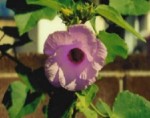Scientific Name: Hibiscus furcellatus
Also Known As: Purple Hibiscus
Indigenous: Kauai, Oahu, Maui, Hawaii
Description: A medium sized hibiscus about eight feet tall with rough leaves that are slight to moderately lobed. New stems, flower buds, and leaf surface are densely pubescent. They have awesome flowers that emerge on tall stems which stand up above the rest of the plant. Each flower is large and has light purple/pink petals with a dark purple center and staminal column. Once pollinated, the calyx will turn brown and be filled with many small, shiny brown seeds.
Distribution: This is the only native hibiscus besides hau (Hibiscus tiliaceus) that is indigenous since it is native to Hawaii as well as Florida all the way down to South America, the rest of the native hibiscus are endemic. Here in Hawaii ‘akiohala is found on Kaua’i, O’ahu, Maui and the Big Island in lowland wet areas but was once much more widespread than its current population.
Cultural Uses: Flowers can be used medicinally as a laxative and also for a dye, while the bark can be stripped and woven into cordage.
Landscape Uses and Care: ‘Akiohala are great as specimen plants and need very little care. Although naturally they are found in wet areas, in the landscape they require very little watering. Basically they require only full sun (which will encourage profuse blooms) with daily watering only until established then watering can be reduced. Watch out for rose beetles that make holes in the leaves. They can be taken care of by either spraying with a systemic pesticide or by placing the plant near a light source at night such as landscape lighting, a porch light or even a street light.
Extra Info: Ever see purple bees before? Well chances are if you own this plant you will. One of the pollinators for this plant are the large black carpenter bees which people often call bumble bees, anyway, when these bees fly into the flower to retrieve nectar their buzzing causes the purple pollen to sprinkle on them covering their whole body so when they fly out, they’re purple. ‘Akiohala also goes by the names ‘Akiahala, Hauhele, and Hauhelewai since it resembles our state flower Ma’ohauhele but is often located near fresh water, wai, hence the name hauhelewai.
Akiohala







